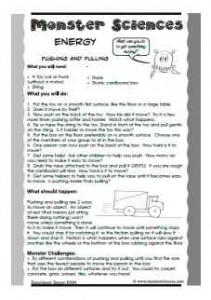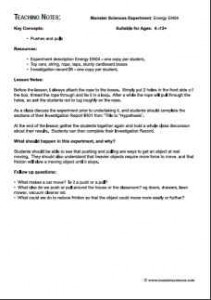Investigate methods of getting things moving – pushing and pulling in this energy science experiment.
 |
 |
What you will need:
• A toy car or truck (without a motor)
• String
• Rope
• Sturdy cardboard box
What you will do:
1. Put the toy on a smooth flat surface, like the floor or a large table.
2. Does it move by itself?
3. Now push on the back of the toy. How far did it move? Try it a few more times pushing softer and harder. Watch what happens.
4. Tie or tape the string to the toy. Stand in front of the toy and pull gently on the string. Is it harder to move the toy this way?
5. Put the box on the floor, preferably on a smooth surface. Choose one of the members of your group to sit in the box.
6. One person can now push on the back of the box. How hard is it to move?
7. Get some help! Ask other children to help you push. How many do you need to make it easy to move?
8. Grab the rope attached to the box and pull it GENTLY. If you are rough the cardboard will tear, How hard is it to move?
9. Get some helpers to help you to pull on the rope until it becomes easy to move. Is pushing easier than pulling?
What should happen:
Pushing and pulling are 2 ways to move an object. An object at rest (that means just sitting there doing nothing) won’t move unless something is done to it to make it move. Then it will continue to move until something stops it. You could stop it by catching it, or the friction pulling on it will slow it down and stop it. Friction is what happens when one surface rubs against another, like the wheels or the bottom of the box rubbing against the floor.
Monster Challenges:
• Try different combinations of pushing and pulling until you find the one that uses the fewest people to move the person in the box.
• Put the box on different surfaces and try it out. You could try carpet, concrete, grass, pavers, tiles, whatever you have!
Teaching Notes: Monster Sciences Experiment: Energy EN04
Key Concepts:
• Pushes and pulls Resources:
• Experiment description Energy EN04 – one copy per student.
• Toy cars, string, rope, tape, sturdy cardboard boxes
• Investigation record IR – one copy per student.
Lesson Notes:
Before the lesson, I always attach the rope to the boxes. Simply put 2 holes in the front side o f the box, thread the rope through and tie it in a loop. After a while the rope will pull through the holes, so ask the students not to tug roughly on the rope.
As a class discuss the experiment prior to undertaking it, and students should complete the sections of their Investigation Report IR01 from ”Title to “Hypothesis”. At the end of the lesson gather the students together again and hold a whole class discussion about their results. Students can then complete their Investigation Record.
What should happen in this experiment, and why?
Students should be able to see that pushing and pulling are ways to get an object at rest moving. They should also understand that heavier objects require more force to move, and that friction will slow a moving object until it stops.
Follow up questions:
• What makes a car move? Is it a push or a pull?
• What else do we push or pull around the house or the classroom? eg doors, drawers, lawn mower, vacuum cleaner etc
• What could we do to reduce friction so that the object could move more easily or further?



